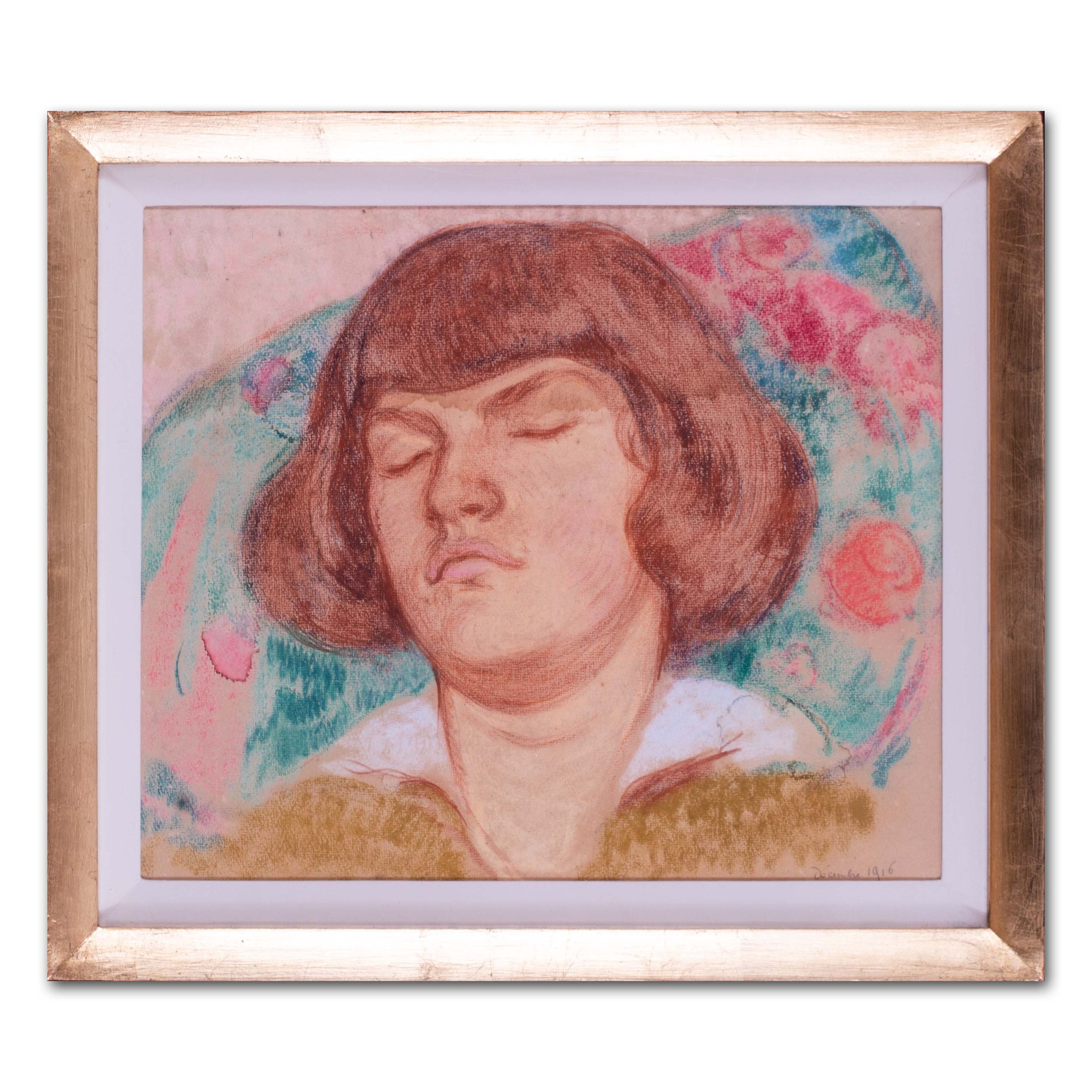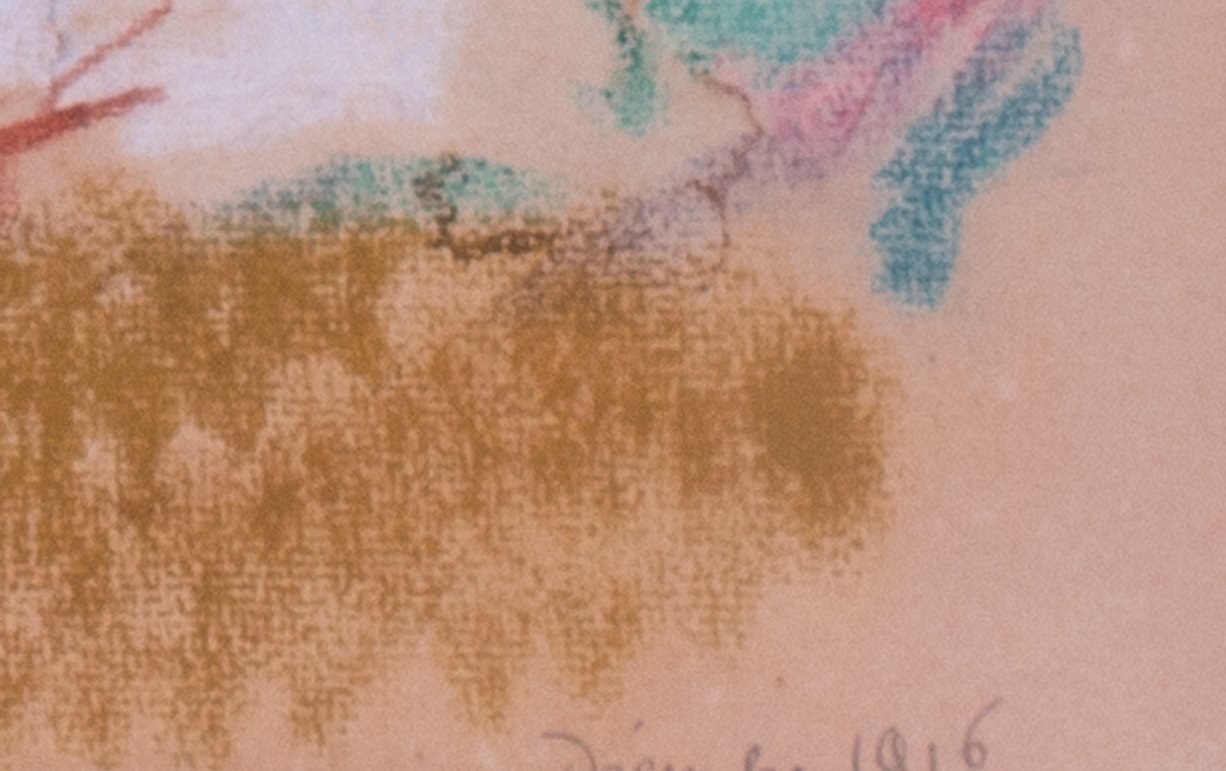 Image 1 of 6
Image 1 of 6

 Image 2 of 6
Image 2 of 6

 Image 3 of 6
Image 3 of 6

 Image 4 of 6
Image 4 of 6

 Image 5 of 6
Image 5 of 6

 Image 6 of 6
Image 6 of 6







Jean van den Eeckhoudt, 'The artist’s daughter Zoum sleeping'
Jean van den Eeckhoudt (Belgian, 1875-1946)
The artist’s daughter Zoum sleeping
Pastel
dated `Decembre 1916’ (lower right)
13.1/4 x 16.1/8 in. (33.7 x 41 cm.)
Jean Van den Eeckhoudt was the grandson of François and the nephew of Isidore Verheyden. He received his initial training from this uncle and became acquainted with Belgian luminism and French impressionism and neo-impressionism. As a former member of "Les XX", Verheyden maintained close contacts with various artists of this art circle, including Georges Lemmen and Théo Van Rysselberghe, with whom Vanden Eeckhoudt became a personal friend. For a short time, he was also apprenticed to Ernest Blanc-Garin, in whose studio he got to know Henri Evenepoel. It is therefore not surprising that Vanden Eeckhoudt's works were initially characterised by an impressionist style of painting and a realistic colour palette. From 1904 onwards, he spent the winters in Menton, where he was impressed by the light and colour of the Mediterranean region. In order to reproduce this wealth of light and colour, he adopted a painting style related to post-impressionism, i.e. a livelier and more cheerful colour palette and a more divisionist brushstroke. In the South, Vanden Eeckhoudt maintained contacts with his good friend Simon Bussy (of the Bloomsbury group), among others, who was a fellow pupil of Henri Manguin and Charles Milcendeau . He became a good friend of Henri Matisse around this time. Probably partly thanks to these meetings, Vanden Eeckhoudt evolved towards a fauvistic style of painting. After 1910, he would use less and less the divided brushstroke and more the colour itself to represent the brilliance of the light. In the next phase, the shapes were further simplified and the composition further refined. Large areas were distributed evenly across the canvas and coloured with more sober tones. During the last twenty years of his life, Vanden Eeckhoudt tried to unite the characteristics of the three previous periods in order to arrive at a more mature style. The drawing was less synthesised and took on a more lyrical character. The colours became less bright than in his Fauvist period and were studied more according to their different tones, which led to a greater sensitivity to space and atmosphere in the works.
Jean van den Eeckhoudt (Belgian, 1875-1946)
The artist’s daughter Zoum sleeping
Pastel
dated `Decembre 1916’ (lower right)
13.1/4 x 16.1/8 in. (33.7 x 41 cm.)
Jean Van den Eeckhoudt was the grandson of François and the nephew of Isidore Verheyden. He received his initial training from this uncle and became acquainted with Belgian luminism and French impressionism and neo-impressionism. As a former member of "Les XX", Verheyden maintained close contacts with various artists of this art circle, including Georges Lemmen and Théo Van Rysselberghe, with whom Vanden Eeckhoudt became a personal friend. For a short time, he was also apprenticed to Ernest Blanc-Garin, in whose studio he got to know Henri Evenepoel. It is therefore not surprising that Vanden Eeckhoudt's works were initially characterised by an impressionist style of painting and a realistic colour palette. From 1904 onwards, he spent the winters in Menton, where he was impressed by the light and colour of the Mediterranean region. In order to reproduce this wealth of light and colour, he adopted a painting style related to post-impressionism, i.e. a livelier and more cheerful colour palette and a more divisionist brushstroke. In the South, Vanden Eeckhoudt maintained contacts with his good friend Simon Bussy (of the Bloomsbury group), among others, who was a fellow pupil of Henri Manguin and Charles Milcendeau . He became a good friend of Henri Matisse around this time. Probably partly thanks to these meetings, Vanden Eeckhoudt evolved towards a fauvistic style of painting. After 1910, he would use less and less the divided brushstroke and more the colour itself to represent the brilliance of the light. In the next phase, the shapes were further simplified and the composition further refined. Large areas were distributed evenly across the canvas and coloured with more sober tones. During the last twenty years of his life, Vanden Eeckhoudt tried to unite the characteristics of the three previous periods in order to arrive at a more mature style. The drawing was less synthesised and took on a more lyrical character. The colours became less bright than in his Fauvist period and were studied more according to their different tones, which led to a greater sensitivity to space and atmosphere in the works.













